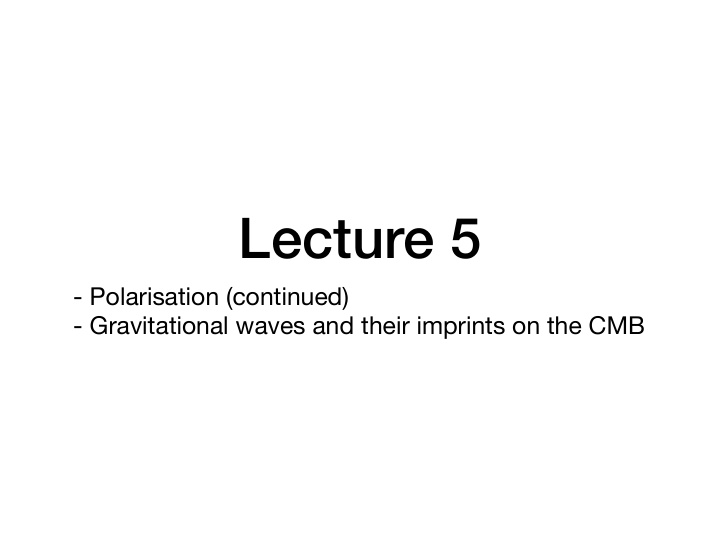



Lecture 5 - Polarisation (continued) - Gravitational waves and their imprints on the CMB
The Single Most Important Things You Need to Remeber • Polarisation is generated by the local quadrupole temperature anisotropy , which is proportional to viscosity
(l,m)=(2,0) (l,m)=(2,1) (l,m)=(2,2) Local quadrupole temperature anisotropy seen from an electron
(l,m)=(2,0) (l,m)=(2,1) L e t ’ s ( l , s m y (l,m)=(2,2) m ) = b ( 2 o , 0 l Hot i ) s e a s Cold Cold Hot
(l,m)=(2,0) (l,m)=(2,1) L e t ’ s ( l , s m y (l,m)=(2,2) m ) = b ( 2 o , 0 l i ) s e a s Polarisation pattern you will see
r L Polarisation pattern in the sky generated by a single Fourier mode
E-mode! r L Polarisation pattern in the sky generated by a single Fourier mode
E-mode Power Spectrum • Viscosity at the last-scattering surface is given by the velocity potential: • Velocity potential is Sin(qr L ) , whereas the temperature power spectrum is predominantly Cos(qr L )
Bennett et al. (2013) WMAP 9-year Power Spectrum
Planck Collaboration (2016) Planck 29-mo Power Spectrum
[1] Trough in T -> Peak in E because C lTT ~ cos 2 (qr s ) whereas C lEE ~ sin 2 (qr s ) [2] T damps -> E rises because T damps by viscosity, whereas E is created by viscosity [3] E Peaks are sharper because C lTT is the sum of cos 2 (qr L ) and Doppler shift’s sin 2 (qr L ), whereas C lEE is just sin 2 (qr L )
[1] Trough in T -> Peak in E because C lTT ~ cos 2 (qr s ) whereas C lEE ~ sin 2 (qr s ) [2] T damps -> E rises because T damps by viscosity, whereas E is created by viscosity [3] E Peaks are sharper because C lTT is the sum of cos 2 (qr L ) and Doppler shift’s sin 2 (qr L ), whereas C lEE is just sin 2 (qr L )
Polarisation from Re-ionisation
Polarisation from Re-ionisation C lEE ~
Cross-correlation between T and E • Velocity potential is Sin(qr L ) , whereas the temperature power spectrum is predominantly Cos(qr L ) • Thus, the TE correlation is Sin(qr L )Cos(qr L ) which can change sign
Bennett et al. (2013) WMAP 9-year Power Spectrum
Planck Collaboration (2016) Planck 29-mo Power Spectrum
TE correlation is useful for understanding physics • T roughly traces gravitational potential, while E traces velocity • With TE, we witness how plasma falls into gravitational potential wells!
Coulson et al. (1994) Example: Gravitational Effects Gravitational Potential, Φ Plasma motion
TE correlation in angular space First, let’s define Stokes parameters in sphere New X-axis: Polar angles θ In this example, they are all Q<0
TE correlation in angular space Put a gravitational potential well at β =0; plasma flows to the centre. What happens?
Komatsu et al. (2011); Planck Collaboration (2016) Average Q polarisation around temperature hot spots Q Planck Data Simulation
Gravitational Waves • GW changes the distances between two points X d ` 2 = d x 2 = � ij dx i dx j ij d ` 2 = X ( � ij + D ij ) dx i dx j ij
Laser Interferometer Mirror Mirror detector No signal
Laser Interferometer Mirror Mirror detector Signal!
Laser Interferometer Mirror Mirror detector Signal!
LIGO detected GW from binary blackholes, with the wavelength of thousands of kilometres But, the primordial GW affecting the CMB has a wavelength of billions of light-years !! How do we find it?
Detecting GW by CMB Isotropic electro-magnetic fields
Detecting GW by CMB GW propagating in isotropic electro-magnetic fields h × h +
Detecting GW by CMB Space is stretched => Wavelength of light is also stretched d l o c h hot o t cold cold h o t hot d l o c
Generation and erasure of tensor quadrupole (viscosity) • Gravitational waves create quadrupole temperature anisotropy [i.e., tensor viscosity of a photon- baryon fluid] gravitationally, without velocity potential • Still, tight-coupling between photons and baryons erases the tensor viscosity exponentially before the last scattering
Scale-invariant Temperature C l from GW
Scale-invariant Temperature C l from GW Entered the horizon after Tensor viscosity the last scattering damped by tight coupling Tensor ISW
Detecting GW by CMB Polarisation Space is stretched => Wavelength of light is also stretched d l o c h hot o t cold cold electron electron h o t hot d l o c
Detecting GW by CMB Polarisation Space is stretched => Wavelength of light is also stretched d l o c h hot o t cold cold h o t hot d l o c
(l,m)=(2,0) (l,m)=(2,1) (l,m)=(2,2) Local quadrupole temperature anisotropy seen from an electron
(l,m)=(2,0) (l,m)=(2,1) (l,m)=(2,2) Cold Hot Let’s symbolise (l,m)=(2,2) as
E-mode!
Pol on the horizon is 1/2 of the zenith E-mode!
Pol on the horizon vanishes B-mode!
• E and B modes are produced nearly equally, but on small scales B is smaller than E because B vanishes on the horizon
Entered the horizon after Tensor viscosity the last scattering damped by tight coupling Tensor ISW Polarisation generated by tensor viscosity at the last scattering
TE correlation Polarisation generated by tensor viscosity at the last scattering
Temperature from sound waves We understand this E-mode from sound waves We understand this B-mode from lensing B-mode from GW We understand this
Temperature from sound waves We understand this E-mode from sound waves We understand this Enjoy starting at these power spectra, and being able to explain all B-mode from lensing the features in them! B-mode from GW We understand this
Recommend
More recommend